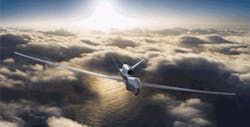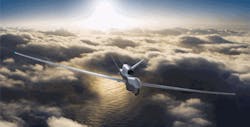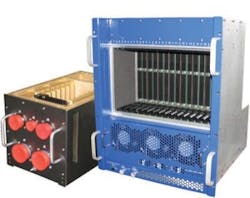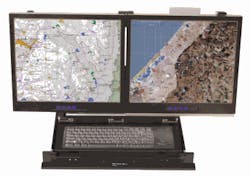COTS and commonality among unmanned aerial vehicle ground control stations
By John McHale
Unmanned vehicles get a larger portion of the U.S. Department of Defense (DOD) budget every year. Unmanned aerial vehicles (UAVs) are less expensive than manned aircraft in terms of hardware and training and can perform nearly all missions that a manned aircraft can.
These flying drones take out enemy combatants with missiles and bombs, but their most valuable tool is the tactical information they gather that is downlinked to ground control stations, analyzed, then sent off to commanders in the field. In the early days of UAV programs, the excitement was centered on the aircraft itself, but today is all about the payload and the critical information it can provide to battlefield commanders long before ground troops are ever deployed.
DOD UAV designers want more capability from their systems in terms of video processing, high-definition infrared imagery, storage, and image processing—and they want it to happen in the air before it is downlinked, says Dennis Smith, vice president of engineering at Themis Computer in Fremont, Calif. This also means the ground control stations are adding more capability too, he adds.
Autonomous missions are the goal—where the UAV is issued a mission plan and executes it while the ground control station is there essentially functioning as a data collection depot, Smith says. Eventually, the ground control station will act like air traffic control (ATC), because several UAVs will operate without one point of control. Essentially the different ground control stations will be networked together to handle collection of the data generated by several UAVs.
In other words the different ground control stations will have to be interoperable. To get interoperability, there will need to be a common architecture and a common set of technology standards and, right now, that is not the case. Every UAV has its own unique ground control station that is not compatible with a ground control station made by a different system integrator.
Common ground control segment
Officials at the Office of the Secretary of Defense (OSD) in the DOD are looking to change that and have formed a working group called the Unmanned Control Systems, Control Segment, or UCS, to drive open standards in UAV ground stations, thereby more efficiently managing costs in the long term, says George Romanski, chief executive officer of Verocel in Westford, Mass. It is an open committee, but limited to U.S. citizens, and focused on UAV programs that are 20 pounds and above, Romanski explains.
The DOD also wants to use the term “control segment” instead of “ground control station” because a ground control station may be on a ship, truck, etc., Romanski adds.
“The UCS working group activities are focused on defining and demonstrating the architecture and standards for future UAV ground control systems,” says Michael Leahy, CMMS program manager at Northrop Grumman. “That effort is not designing a specific instantiation of that architecture. Northrop Grumman is on contract to support the activities of the OSD UCS working group.”
“The DOD is fed up with paying for specific control segments, especially in the current budgetary environment in Washington,” Romanski continues. “Each UAV—Global Hawk, Predator, and others—has its own control station with its own unique hardware and software configurations that are often quite different from platform to platform. The DOD wants to develop a uniform standard for the software architecture used to cut down on costs in the long run.”
Hence, they are “getting serious about an open business model, where an ecosystem of suppliers can evolve and develop services that can be integrated into a control segment,” Romanski says. “The UCS has defined a large infrastructure of specifications and use cases, and is working toward defining a platform-independent model that may be used by a program of record to implement a platform-specific model or platform-dependent model. The services are loosely coupled, which enables organization and structuring of the underlying architecture using the services selected from a hopefully, growing repository.”
The user working group worked for the first year to establish a proposed architecture description, “in other words, what it should look like,” Romanski explains. The architecture will be finished by the end of this year, and then followed by the platform-dependent models, he continues. “The platform dependent models will take the architecture and adapt it to the individual platforms. The result will be that each platform is using the common standards set out by the committee.”
“The model is being defined by the UCS-WG and phase 2 is expected to be completed at the end of this year,” Romanski continues. “It means that vendors who currently supply the flying platforms will no longer develop control segments which are specific to the vehicle to which they are linked. One control segment will be able to control many different types of vehicles.
“The work is progressing well,” Romanski says. “We are not only working the architecture side, but also addressing the safety and security certification needs. The defined architecture will have various interfaces based on NATO STANAG 4585, which is specifically designed for UAV interface systems,” he continues. “All the services will be interlinked and you can construct a system of choice by putting together the services you need.”
However, when it comes to upgrading current ground control stations to the new architecture, “the decision to upgrade each ground control station will need to be made by each government program office based on the cost benefit analysis for their individual UAV,” Leahy says.
COTS integration trends
Even though the UCS architecture is still in development, COTS hardware and software has a strong foothold in the ground control station system designs.
“Both the Air Force and Navy are implementing commercial hardware for their future ground station servers and consoles,” Leahy says. “On the software side, the dominant trend is a move to non-proprietary scalable, standards-based [service-oriented architecture] frameworks with well-defined service interfaces that allow easy integration of third-party services/applications. We also envision the continued migration of advanced capabilities from the ground control system to on-board the UAV.”
“In future systems—like the Broad Area Maritime Surveillance (BAMS) UAV—the displays, data management, and mission management hardware will be generic/commercial and could be by many vendors,” says Bill Walker, business development manager, Global Hawk at Northrop Grumman. “Communications systems are also going through an upgrade to a new architecture, and the communications hardware is still to be determined.”
While in the past, ground control station integration has used classic COTS, such as VME boards, there is a push to use more ordinary PC technology because the ground control station is a benign environment, says Andrew Hipperson, director of business development for video and display solutions at Curtiss-Wright Controls Embedded Computing in Hartfordshire, England. Sometimes for field-deployed control stations, rugged systems are required but not typically in the air-conditioned ones located in bunkers, Hipperson adds.
Curtiss-Wright’s off-the-shelf Orion mezzanine card is used for compression of video that comes in from the UAV sensors on the downlink, Hipperson says. This area is trending toward commercial high-definition video technology, he says. If the video is not used for real-time steering and general guidance, there is no need to have the image downloads instantly. The wait is worth it for the high-definition images.
“Servers are covering the spectrum from basic appliances that gate keep network traffic between various levels of security, to the highest possible super computing platforms with dual hexa-core motherboards hosting dual tesla mega-cores that can, in real time, process full motion video images from HD sensors,” says Todd Prouty, business development manager at Crystal Group in Hiawatha, Iowa. The technology trends are toward state-of-the-art IT equipment as many are “pushing the envelope on data transfer speeds for copying and storing vast quantities of video data or modest quantities of secure sensor data which require custom packaging.”
For ground control station applications, Crystal supplies their standard RD2119 single display/keyboard, RD2217 dual display, and RS255 RAID head server, Prouty says.
Ground control station integrators “are typically looking for forward-deployable, rack-mounted servers, data storage, network switching, and display products,” Prouty says. They want “ground fixed environmental compatible equipment, others want a ground mobile environment as they require operation while the support vehicles are in motion.”
Traditionally, VME and SPARC boards have been supplied for ground control station applications, such as Themis does for the Fire Scout and Shadow UAVs, Themis’ Smith says. VME is still used, but ground control station integrators are looking more toward commodity-based solutions, such as X86 processors, he adds.
The RES 32 SPARC system from Themis is used in the Northrop Grumman Fire Scout UAV control station onboard Navy ships, while the company supplies a Xeon board for the Shadow UAV ground control station, Smith says.
Today, there is a migration from VME cards into more box solutions or 19-inch racks with Extended ATX or ATX boards, Smith says. They can fit more into these solutions in terms of increased processing capability and computer performance, which is “hard to do on a VME card,” he explains.
Processors in ground control stations are typically X86 devices from Intel with AMD processors seen as the alternative, Smith says.
However, not all payloads in UAVs use COTS technology. “Because of the large bandwidth of data created by the payloads on Global Hawk, there are specialized communications, encryption, and data management systems in the ground station,” Northrop Grumman’s Walker says.
Linux
When it comes to operating systems—Linux and even Windows are being used, Hipperson says.
“We run Linux on all our systems, but we still see SPARC with Solaris. Linux has taken over wholesale unless real-time functionality is required, then you get a traditional, real-time operating system (RTOS) from Wind River, Green Hills Software, or LynuxWorks,” Smith says. “It is primarily Linux for embedded systems.”
Common control segment to be certified for safety and security
Members of the Unmanned Control Systems, Control Segment (UCS) working group—run by the Office of the Secretary of Defense (OSD) are developing an architecture for future UAV control stations that will be not only embrace open standards, but meet critical safety and security certification requirements, as well.
“The architectural approach for a common ground control segment is an open, flexible, scalable, and partitioned platform that addresses both information assurance and safety,” says Chip Downing, director of military and aerospace at Wind River Systems in Alameda, Calif. “Designers then would be able to take existing functions and services which reside on federated platforms and migrate them to an open, partitioned environment which suit their mission needs.”
The MILS, multiple independent levels of security, approach is being adopted for this architecture.
“MILS enables a common secure foundation that supports different levels of security domains on one hardware platform, allowing the connection of diverse security domains, like the U.S. Army and coalition partners, on one shared device,” Downing says. “This same strategy could be expanded to support the connection of different security levels of different government services and agencies.
“The goal is to migrate our traditional standalone, federated systems to a common shared compute platform than can support both enterprise applications running on enterprise operating systems, like Windows and Linux, alongside applications that are more time and security-critical,” Downing says. “With a secure hypervisor as a foundation, you remove the configuration and upgrade challenges and bounds of a static operating system running directly on the hardware.”
The common control segment must be certified for safety to fly in the national airspace, says George Romanski, chief executive officer of Verocel in Westford, Mass. “Once the safety and security case are defined, then we will make sure the platform-specific systems are also compliant with safety and security in an integrated, modular avionics (IMA)-like architecture.”
Where DO-178B certification is needed will depend on the program of record, Romanski says. “Some will need to be secure but not safety certified for flight. A lot of it will depend on how the program is architected for its mission. For example, the video service used for the mission may have secure video feeds but will have nothing to do with flight operations and, therefore, will not need to be safety certified.”
More Military & Aerospace Electronics Current Issue Articles
More Military & Aerospace Electronics Archives Issue Articles




